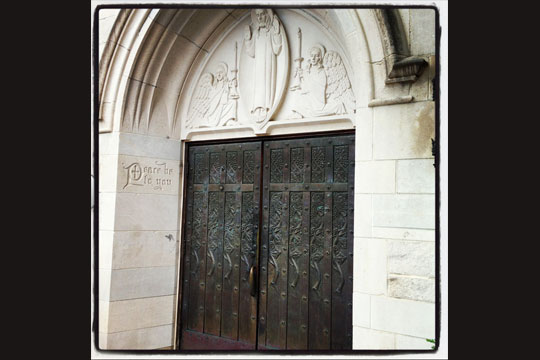
During the last week of school, I take my third graders on a pilgrimage around our school and parish campus. I started this practice during the Jubilee Year of 2000, when I led a pilgrimage for my school community. We didn’t go far: we just walked the grounds of our campus. I loved this opportunity to experience my faith in a new way.
What is a pilgrimage and why do people make them? A pilgrimage is simply a journey to a holy place. It’s also a time set aside to notice our surroundings and to thank God for the blessings he has given us. Pilgrimages are a time-honored practice of our faith. People go on pilgrimages for any number of reasons: to praise God in a special place, to fulfill a promise, or to pray for a special intercession. Many times the pilgrim is inspired and transformed.
To lead your own school pilgrimage, begin by picking seven or eight stops around your school and parish campus. These stops may include artwork that is important to your parish, such as a statue of the Blessed Virgin Mary or the parish’s patron saint, religious paintings, or icons. Make sure your pilgrimage includes the doorways of your school and church—after all, you are symbolically opening the door of faith for your students.
If you have a school banner or a processional cross, have someone carry it at the head of the pilgrimage. This an excellent way to mark your pilgrimage as a holy journey.
At each stop, take time to notice the surroundings. Have the students point out things they might not have seen before. Then read a brief reflection. A refrain from a song or Scripture verse can be used in place of a reflection. Before you move on to your next stop, pray the Lord’s Prayer, the Hail Mary, or the Glory Be to the Father. These short prayers will define your stops as something special and holy.
The first stop in my school pilgrimage is at our school’s front door, where we sing the refrain to the song “Holy Ground” by Christopher Beatty.
We also stop at our prayer garden, where there is a large statue of Jesus with children. We end the pilgrimage at the front door of our church. At this stop, we pay close attention to the beautiful stone relief above the doors. The words “Peace be with you” are etched in the stone. My students always say, “I’ve never noticed that!” I read a reflection reinforcing that this greeting is for them and all who enter this church. We then walk quietly into the church.
The partially lit church really sets a special tone every year for our pilgrimage. My students are so used to every light being on and the pews filled. We walk quietly to the front and sit in the first few pews. At this time, I answer questions from my students. They ask great questions. Many times after I answer a question, they will say, “I never knew that!” I point out the baptismal font, and we pray the Apostles’ Creed.
I share with the class how I go on my own pilgrimages during the summer by attending Mass at different churches. I love seeing how each church is similar yet different. I always like seeing how the tabernacle is different at each church. I challenge the children to find the tabernacle at each parish they visit.
As we walk back to our classroom after our pilgrimage, I encourage my students to share their experience with their parents and share this short motto I give them for the summer: “Read, Play, and Pray!”
Do you have any special traditions to mark the end of your school year? How do you help your students live their faith over the summer?





Love this idea and your explanation, Barb. What a great way to make the pilgrimage experience real for the children. I’m sure your students are more aware of their surroundings now – and they’ll take that awareness with them for future experiences.
Thank you Kris for your comment. I hope you give a pilgrimage experience a go with your students!
Hi my teens have been confirmed on the 11th of September Im in need of activities that are exciting and will affirm their faith